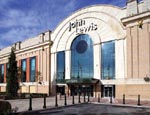Weighing in at 1.9m sq ft and 1.4m sq ft respectively, the Trafford and Arndale shopping centres are the sumo heavyweights of Manchester’s retail scene. With the Arndale Centre steadfast in the city centre, and the Trafford Centre positioned on Manchester’s outer fringes, the schemes have traditionally been competitors at best, enemies at worst.
But now, with Arndale co-owner Capital Shopping Centres buying the Trafford Centre in a £1.6bn deal with John Whittaker’s Peel Group, it looks like peace is finally breaking out. Or is it?
Overnight, CSC has come to dominate Manchester’s shopping scene. But although the city’s two biggest schemes are now largely in the hands of the same owner, managers at both centres know they still have a fight on their hands to keep their offers fresh, and both are preparing big changes.
CSC declined to speak to EG about future plans ahead of announcements likely later this spring, but the contours of its strategy are already clear.
First to Peel’s Trafford Centre, outer Manchester’s cross between a Las Vegas resort and a Romanesque palace. Bid documents from the deal with Peel suggest that CSC sees significant asset management opportunities to increase estimated rental value at the scheme, with an estimated £50m of investment opportunities already identified.
Large new stores will be the centrepiece, with the aim of attracting brands until now associated with the city centre rather than the out-of-town mall. House of Fraser is understood to be in pole position, with Argos and Primark also in the frame.
New stores will be carved out of existing shops and backstage areas, but there could also be additional floors created over the main malls, new stores in the Barton Square element of the scheme, and further development on adjoining plots.
Meanwhile, how to squeeze more large units into the fully-let Arndale Centre is causing its management a headache. Unlike at the Trafford Centre, the tight city centre site allows much less scope for extension. Realigning existing stores will be difficult and time-consuming, and there are limited opportunities for using backstage areas.
But the Arndale management aims to freshen up the retail mix. The anchors are the mixed bag of Boots, Next, Bhs, Littlewoods, Topshop and Argos. Deals with US brands Hollister and Forever 21 are expected. But providing the latter brand with the 50,000 sq ft it is understood to be after will require innovative solutions.
“We’ve got supply tensions,” says Andrew Foulds, asset manager at Arndale co-owner PRUPIM. “We need to take some tenants out and find the right replacements. That is going to be challenging.”
He adds: “We are looking at ways to carve new, larger stores out of the existing space. We will have to be inventive.”
The city’s retail agents are keen to see a shake-up of the Trafford and Arndale centres, but most acknowledge that the problems are inherent.
Warwick Smither, partner at Manchester retail specialist Cheetham & Mortimer, says: “Trafford would like, or needs, a bigger Marks & Spencer and a smaller Boots, but the centre is generally in good health, with an average number of voids and normal tenant turnover.
“The Arndale needs bigger stores or anchors. Does Next perform the function of anchoring the extension? Not like Debenhams or John Lewis would. But, again, it is not in a bad shape considering the economy, the size of the scheme, and the lack of a major anchor or anchors.”
Both PRUPIM and CSC insist the two centres do not compete. Arndale customers go shopping in the day; Trafford shoppers in the evening, they say. Arndale customers come by bus or tram; Trafford customers by car. They cater for two distinct segments of the market, it is argued.
“The two centres are not competing directly,” insists Foulds.
Some retailers say privately that there are benefits in the two centres sharing common ownership. For example, cross-selling and cross-promotion opportunities are said to be dazzling marketing departments at both CSC and PRUPIM.
Stephen Elrington from Jones Lang LaSalle’s retail agency team says: “Many retailers are confidently taking a dual location strategy in both centres, which between them attract more than 60m visitors each year.”
The two sumo of Greater Manchester retail will continue to battle for shoppers. CSC will be hoping that it can bulk up both its schemes to provide the region with a knock-out offer.
The weigh in
Early this year, Capital Shopping Centres agreed a £1.6bn deal with Peel Group to buy the Trafford Centre, outflanking a last-minute bid from US-based Simon Property Group.
The deal also saw former owner Peel invest £77.7m in exchange for a 19.9% stake in CSC, while billionaire owner John Whittaker will be appointed deputy chairman.
The Office of Fair Trading will decide on 3 May whether to investigate CSC’s purchase of the scheme. CSC owns four of the UK’s top six shopping centres, and the fear is that CSC wields too much power over retailers. CSC says it will co-operate, but insists the deal raises no competition issues.
• CSC bought into the Arndale in 2005 buying a 50% stake from PRUPIM as part of a £635m deal, which also included Cribbs Causeway in Bristol.











